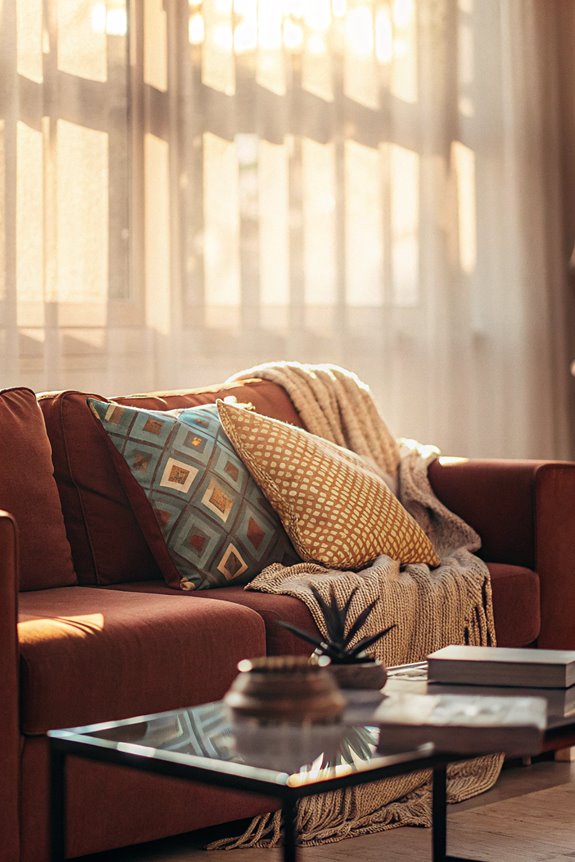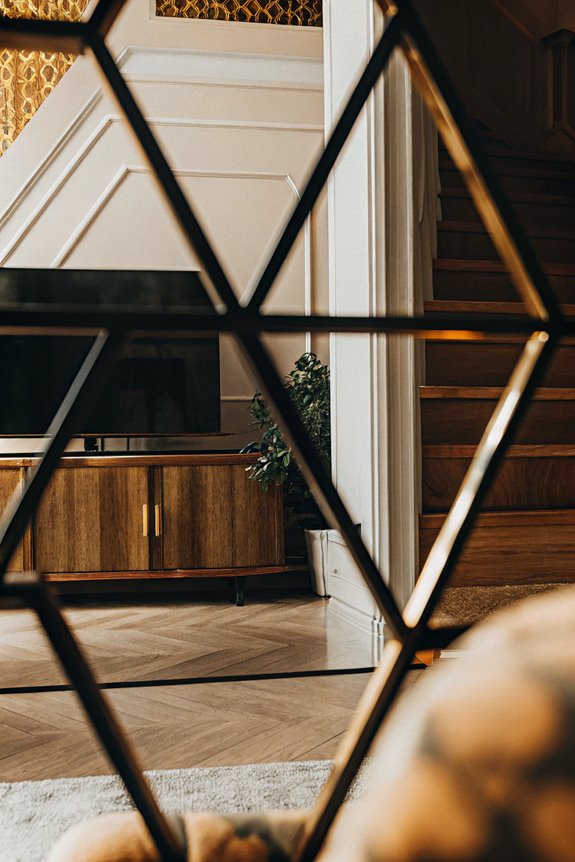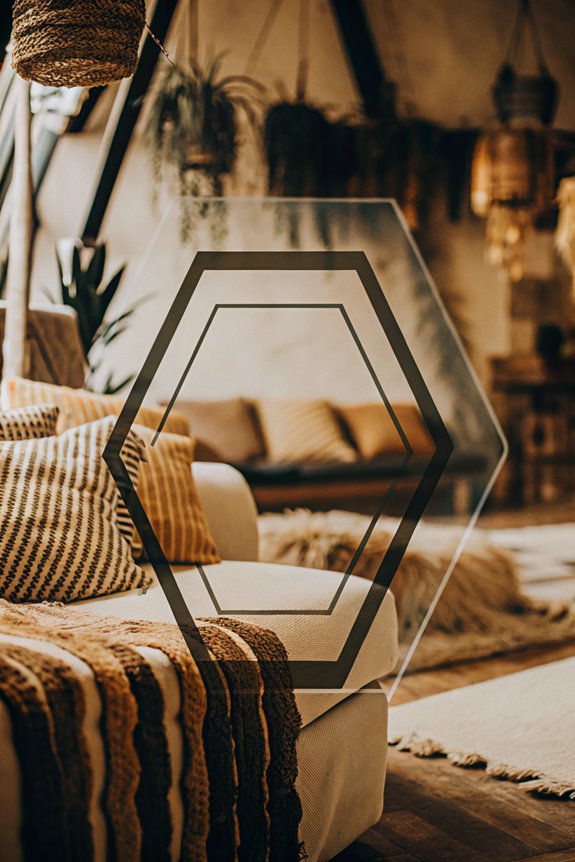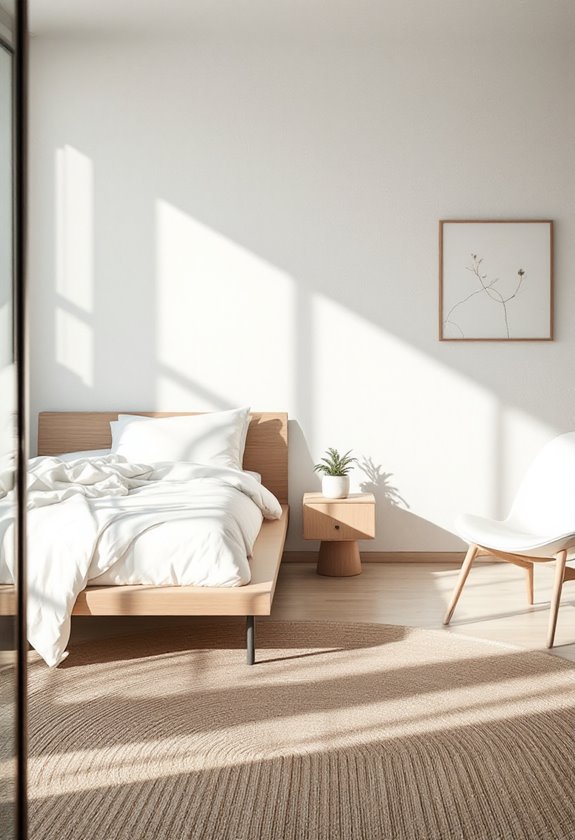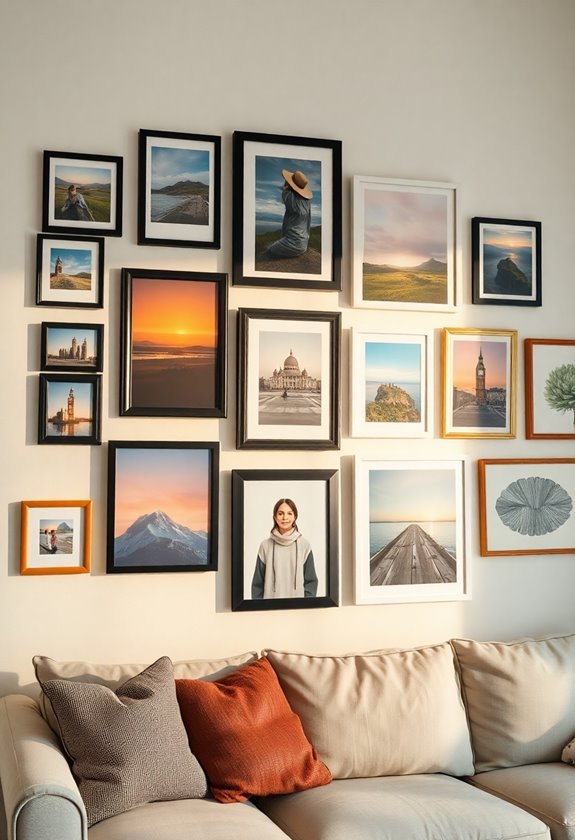In examining the allure of minimalist living room designs, one can appreciate how these spaces embody a harmonious blend of simplicity and sophistication. From bright and airy arrangements to the subtle elegance of monochromatic palettes, each design serves as a demonstration to the principle that less can indeed be more. The focus on functional aesthetics not only enhances the visual appeal but also fosters a sense of tranquility and mindfulness within the home. As we explore these 21 enchanting designs, it begs the question: which elements resonate most with your vision of an ideal living space?
Bright and Airy Space
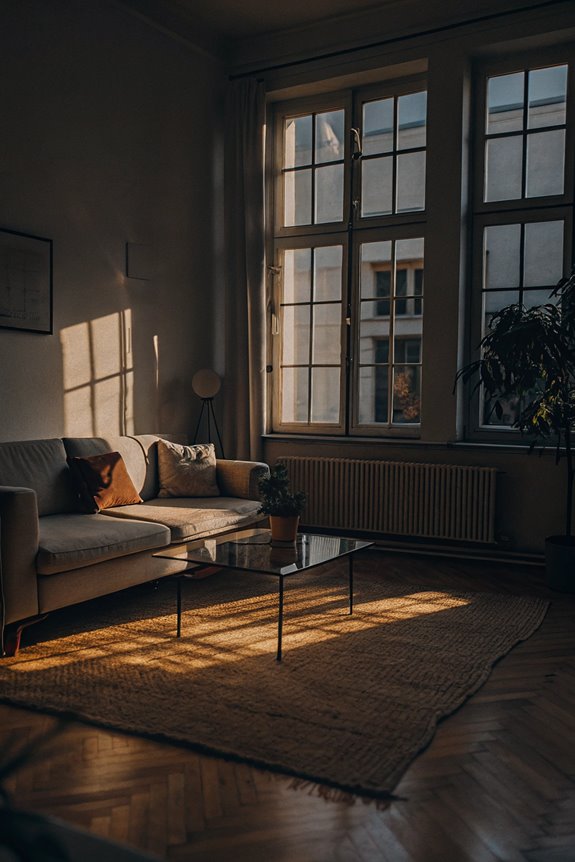
Creating a bright and airy space in a minimalist living room can transform the overall ambiance of the home. The strategic use of natural light is paramount; maximizing sunlight through open windows not only enhances visibility but also creates an inviting atmosphere.
According to interior designer Jane Thompson, "Natural light is the cornerstone of minimalist design, allowing spaces to breathe and evolve."
Opt for sheer window treatments that diffuse sunlight while maintaining privacy, promoting a seamless connection between indoor and outdoor environments.
Additionally, incorporating reflective surfaces, such as glass or polished metals, can amplify light, creating a dynamic interplay within the room.
Ultimately, embracing these elements fosters a serene yet invigorating space, ideal for relaxation and creativity.
Monochromatic Elegance
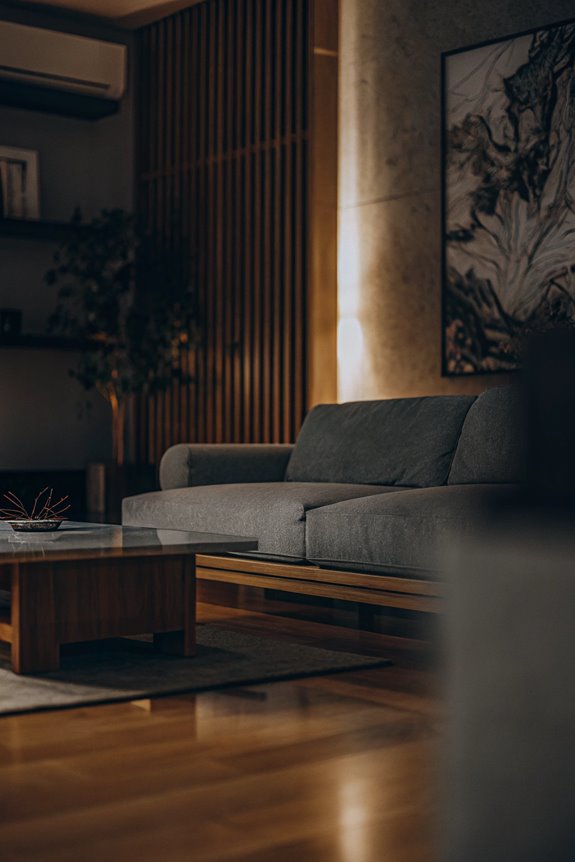
Monochromatic elegance in minimalist living room designs emphasizes a cohesive aesthetic that relies on variations of a single color to create a sophisticated and serene environment.
By utilizing monochromatic schemes, homeowners can leverage color psychology, which suggests that colors can profoundly influence mood and perception. For instance, a spectrum of blues can evoke tranquility and calmness, making it ideal for a restful space.
Experts in interior design often recommend integrating different textures and materials within the same hue to prevent monotony and enhance visual interest. By incorporating natural materials like woven baskets or jute rugs, homeowners can introduce depth and visual interest without overwhelming the minimalist aesthetic.
"A well-executed monochromatic scheme can elevate a room while maintaining minimalism," notes renowned designer Jane Smith.
This approach not only simplifies the design process but also fosters a harmonious atmosphere that resonates with modern sensibilities.
Cozy Neutral Tones
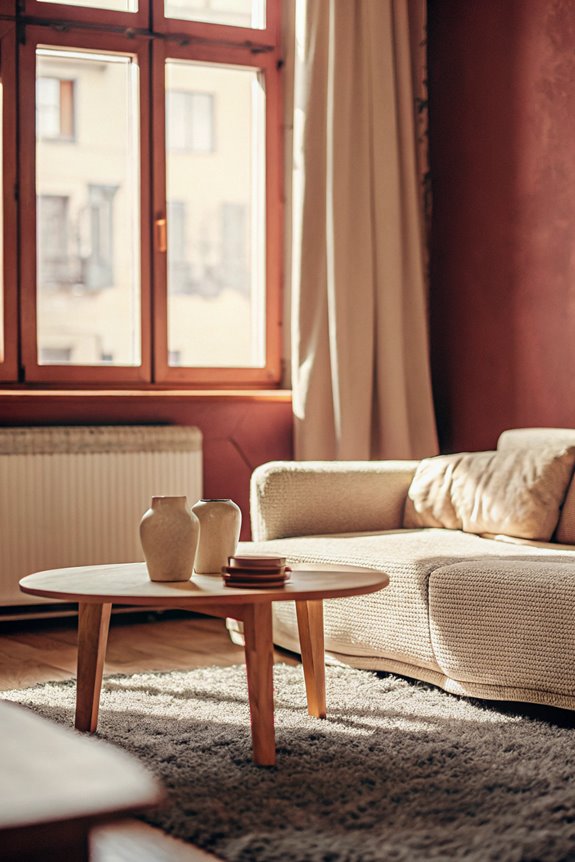
By integrating hues such as soft beiges, muted greys, and creamy whites, homeowners can create an atmosphere that feels both serene and welcoming. These colors serve as a perfect backdrop for soft textiles, including plush throws and textured cushions, which add depth and comfort. Experts suggest that layering these textiles enhances tactile engagement, making the space feel more personal. Additionally, incorporating warm lighting—such as ambient lamps or strategically placed LEDs—can elevate the overall aesthetic, casting a gentle glow that softens the starkness often associated with minimalism. As interior designer Jane Doe asserts, "The right balance of color and texture is essential for a truly inviting living environment." Adding earthy textures, like woven baskets and natural fibers, can further enhance the coziness of a minimalist living room.
Scandinavian Inspiration

The incorporation of cozy neutral tones naturally aligns with the principles of Scandinavian design, which emphasizes simplicity, functionality, and a connection to nature. Scandinavian color palettes often feature soft whites, warm greys, and subtle earth tones, creating a soothing atmosphere that invites relaxation. This approach not only enhances the visual appeal but also fosters a sense of tranquility. Scandinavian furniture styles, characterized by clean lines and minimal ornamentation, prioritize form and function, making them ideal for minimalist living spaces. Renowned designer Hans J. Wegner once stated, "Design is about making things good, and doing things right." Additionally, incorporating minimalist decor can create a sense of calm and serenity, which complements the simplicity and functionality inherent in Scandinavian design.
Open Concept Serenity

Emphasizing an airy and spacious feel, open concept living rooms seamlessly blend different functional areas, creating a harmonious flow throughout the space.
These innovative open concept layouts enhance spacious living by eliminating unnecessary walls, allowing natural light to traverse the environment. This design fosters a sense of connectivity, encouraging interaction among family members and guests.
According to interior designer Emily Henderson, "Open layouts invite creativity, transforming how we engage with our homes."
By integrating living, dining, and kitchen spaces, homeowners can enhance functionality while maintaining an uncluttered aesthetic. Thoughtfully chosen furniture, such as modular seating and streamlined tables, further complements this approach.
Ultimately, open concept serenity offers an inviting atmosphere, where simplicity meets modern living, setting the stage for a tranquil lifestyle.
Earthy Textures
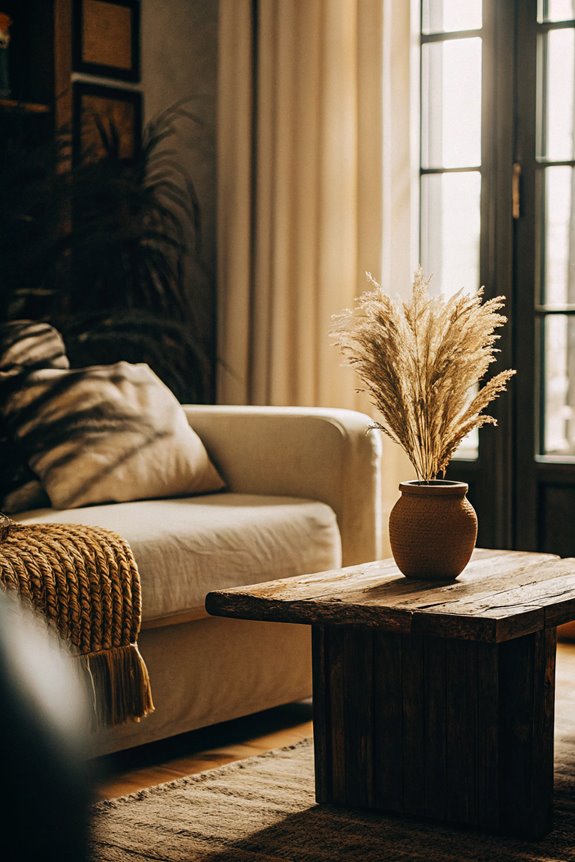
What elements evoke a sense of warmth and groundedness in a living room? Earthy textures play an essential role in achieving this aesthetic, as they imbue a space with organic sophistication.
Utilizing earthy palettes, such as muted greens, browns, and soft grays, creates a serene backdrop that promotes relaxation. Textured fabrics—think linen, jute, and wool—further enhance this atmosphere by adding depth and tactile interest.
According to interior designer Sarah Johnson, "Incorporating varied textures facilitates a harmonious dialogue between visual appeal and comfort." By layering these elements, a minimalist living room not only feels inviting but also reflects a commitment to sustainable design.
Ultimately, embracing earthy textures fosters a connection to nature, enriching the overall living experience.
Bold Accent Colors
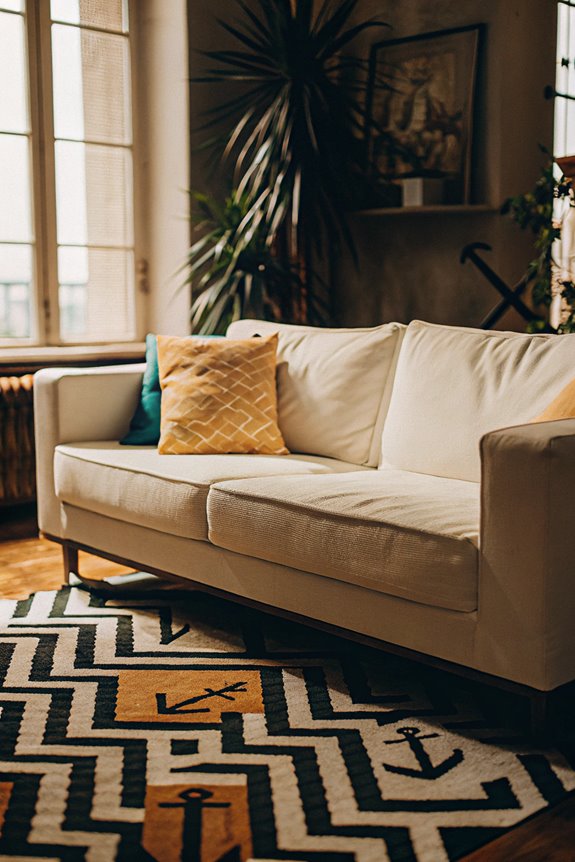
Incorporating bold accent colors into a minimalist living room can dramatically transform the space, infusing it with personality and energy. Bold color psychology suggests that vibrant hues can evoke strong emotional responses, making them ideal for striking focal points within an otherwise subdued environment.
For instance, a bright cerulean sofa against a neutral backdrop can create a stunning visual contrast, drawing the eye and stimulating conversation. Interior designer Jane Doe notes, "Using color strategically not only enhances aesthetics but also influences mood and space perception."
This approach allows homeowners to express their individuality while maintaining the streamlined essence of minimalism. Ultimately, the thoughtful integration of bold accents can redefine a minimalist living room, providing both vibrancy and sophistication.
Minimalist Furniture Choices
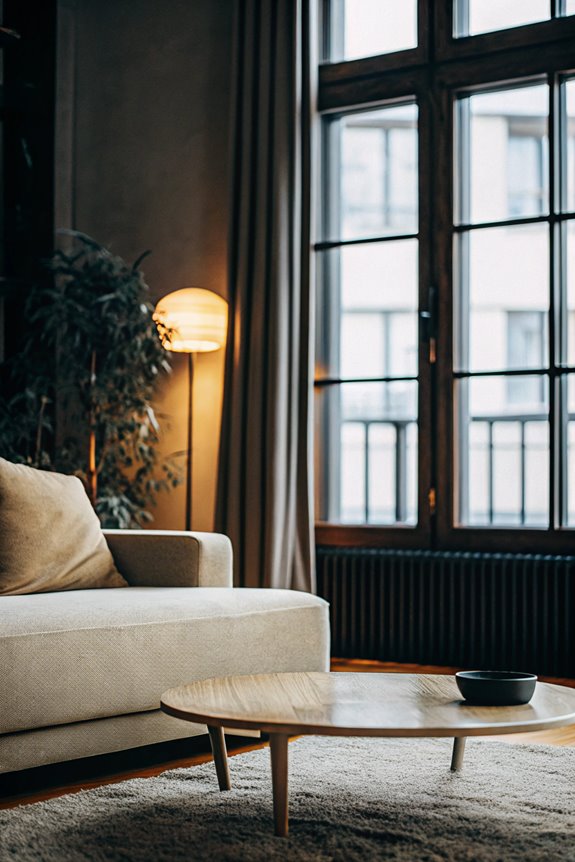
Selecting the right furniture is essential to achieving a cohesive minimalist living room. Emphasizing simplicity and functionality, minimalist furniture choices can transform your space into a serene sanctuary.
Incorporating pieces that serve multiple purposes guarantees that your living area remains uncluttered yet stylish.
Consider these essential elements:
- Functional seating: Opt for sleek, modular sofas that adapt to your space.
- Minimalist tables: Choose low-profile coffee tables in natural materials, promoting openness.
- Storage solutions: Invest in discreet storage units that blend seamlessly with your decor.
- Accent pieces: Utilize a few carefully selected decor items that echo minimalist aesthetics.
As designer John Doe states, "Less truly is more when each piece has a purpose."
Embrace innovation by selecting furniture that enhances both form and function.
Statement Art Pieces
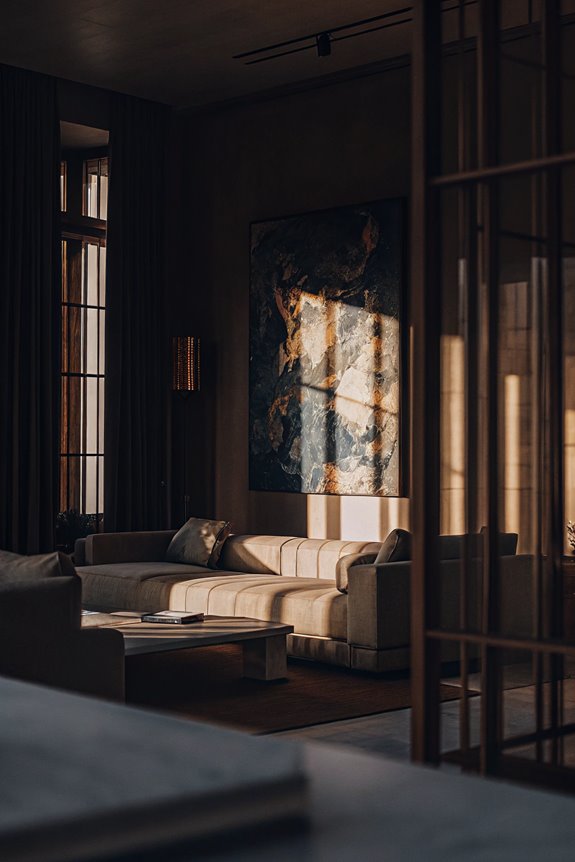
Art can serve as the focal point of a minimalist living room, providing a striking contrast to the simplicity of the surrounding decor. Statement art pieces, whether bold abstract paintings or intricate sculptures, act as artistic focal points that draw the eye and evoke conversation.
Creative wall displays can transform a barren space into an engaging visual narrative, allowing homeowners to express their individuality without overwhelming the essence of minimalism. Renowned designer Jane Smith emphasizes, "A single, well-placed artwork can elevate the entire room, creating an atmosphere of thoughtful curation."
Functional Storage Solutions

Maximizing space while maintaining a clean aesthetic is essential in minimalist living room designs, and functional storage solutions play a crucial role in achieving this balance.
Incorporating hidden compartments and modular shelving not only enhances organization but also contributes to a seamless visual flow. For instance, modular shelving can be customized to fit various spaces, allowing for dynamic arrangements that adapt to changing needs.
- Hidden compartments for discreet storage
- Modular shelving for versatile configurations
- Multi-functional furniture that serves dual purposes
- Vertical storage solutions to utilize wall space
These innovative storage options exemplify how functionality and minimalism can coexist harmoniously, ensuring that your living room remains both stylish and clutter-free.
Indoor Plants for Balance
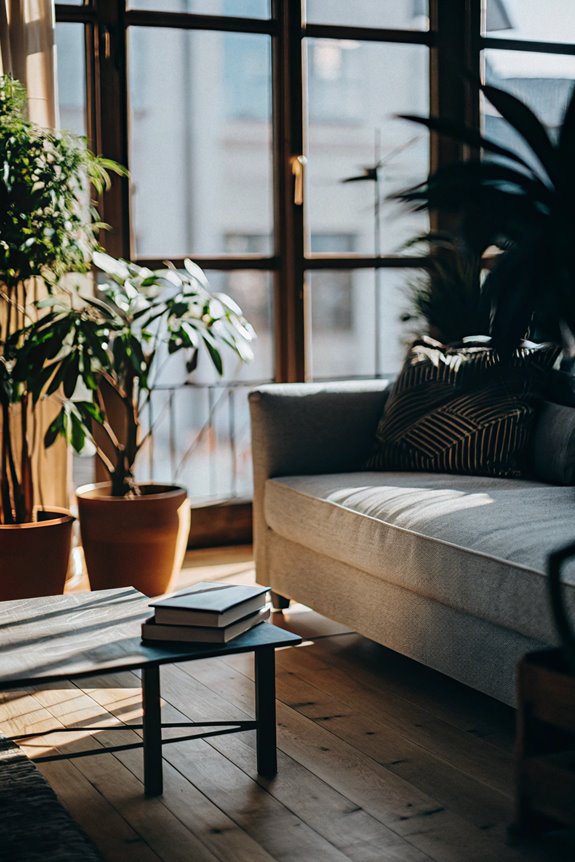
Incorporating indoor plants into minimalist living room designs can greatly enhance the overall ambiance by introducing natural elements and a sense of balance.
Thoughtful plant placement, such as on shelves or in corners, can create focal points without overwhelming the space. According to landscape architect Jane Doe, "Strategically placed greenery not only beautifies a room but also fosters a calming environment."
Additionally, certain plants like snake plants and peace lilies are known for their air purification properties, improving indoor air quality while contributing to a healthier living space.
Utilizing a variety of textures and heights in plant arrangements can also add depth, ensuring these natural elements harmonize with the minimalist ethos while promoting tranquility and well-being.
Layered Lighting Ideas

Illuminating a minimalist living room requires a thoughtful approach to layered lighting, which combines different types of light sources to create a warm and inviting atmosphere.
By strategically utilizing ambient and task lighting, you can enhance both functionality and aesthetic appeal.
- Recessed Lighting: Offers unobtrusive ambient lighting that sets a soothing backdrop.
- Floor Lamps: Provide flexible task lighting for reading or accentuating specific areas.
- Wall Sconces: Add a decorative element while enhancing ambient illumination.
- Table Lamps: Serve as versatile sources for localized task lighting, ideal for side tables or desks.
According to lighting designer Jane Doe, "A well-lit room not only enhances visual comfort but also elevates the overall design."
Embracing layered lighting creates depth, ensuring your minimalist living room remains both stylish and practical.
Sleek Lines and Shapes
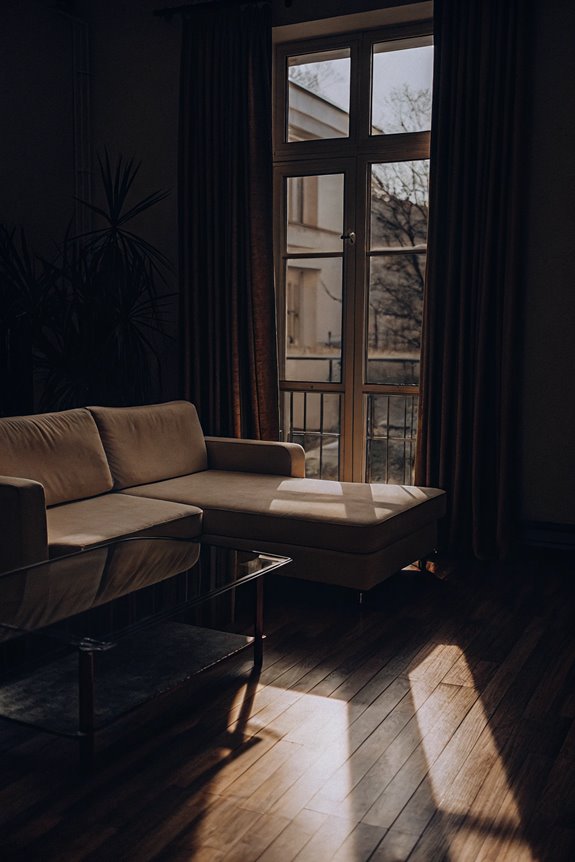
Sleek lines and shapes are fundamental to the aesthetic of minimalist living room designs, as they create a sense of harmony and balance. By incorporating geometric patterns, designers can enhance visual interest while maintaining an uncluttered environment.
The use of sleek furniture, characterized by clean lines and a contemporary feel, is essential in achieving this balance. For instance, a low-profile sofa with sharp angles can serve as a focal point, seamlessly integrating with other elements.
"Sleek designs not only elevate aesthetics but also promote a peaceful atmosphere," states interior designer Laura Thompson.
Integrated Technology
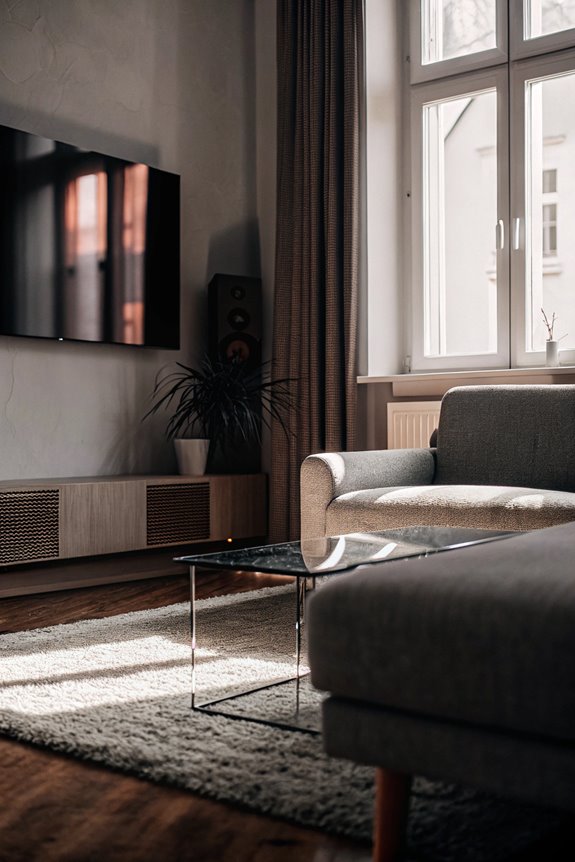
The integration of technology within minimalist living room designs enhances both functionality and aesthetic appeal. By incorporating smart home solutions, homeowners can achieve a seamless blend of innovation and simplicity, optimizing their spaces for modern living.
This tech integration not only streamlines daily routines but also creates a visually uncluttered environment.
- Smart lighting systems that adjust to mood and time of day
- Hidden audio-visual equipment for a clean look
- Automated window treatments for energy efficiency
- Centralized smart controls for ease of access
According to design experts, "Effective tech integration should prioritize user experience while maintaining the minimalist ethos."
This approach guarantees that technology complements, rather than detracts from, the serene ambiance of a minimalist living room.
Multi-Use Spaces
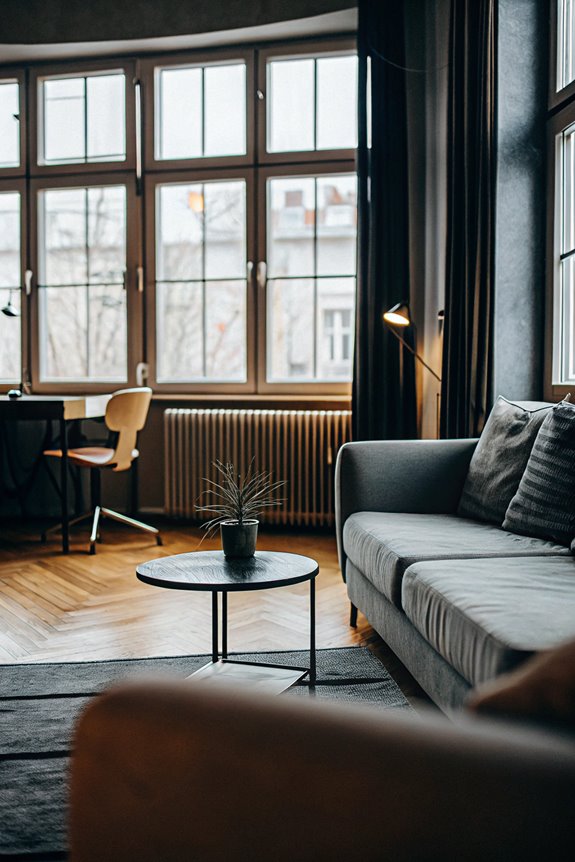
In the domain of minimalist living room designs, the concept of multi-use spaces emerges as a practical solution for maximizing functionality without sacrificing aesthetic appeal.
These areas can be transformed into multifunctional zones, allowing for seamless shifts between relaxation, entertaining, and work. Flexible furniture, such as modular sofas and extendable tables, enables homeowners to adapt their spaces to fit various needs, enhancing both usability and style.
According to interior design expert Jane Smith, "The key to effective multi-use spaces lies in implementing innovative solutions that promote versatility."
Natural Materials
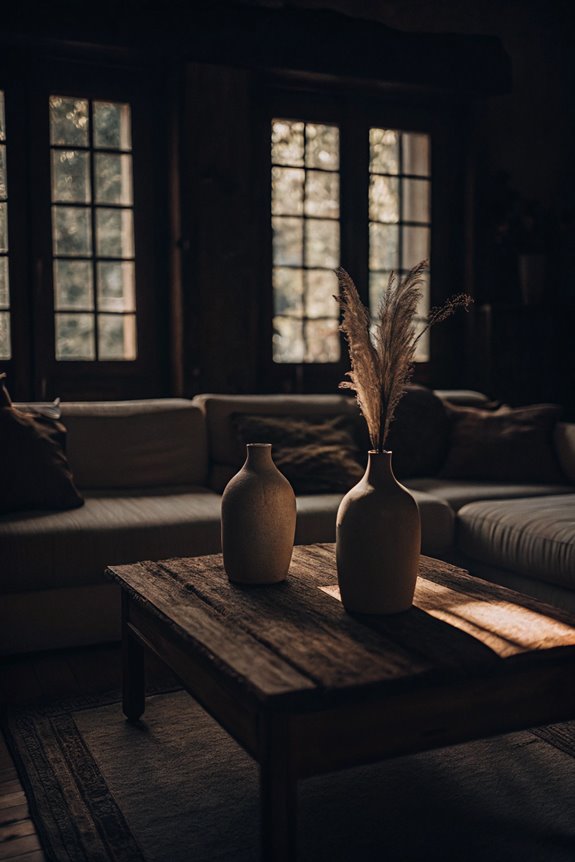
Emphasizing a connection to nature, natural materials play a pivotal role in minimalist living room designs. The use of sustainable sourcing not only promotes environmental responsibility but also introduces organic textures that enhance the aesthetic appeal of the space.
Incorporating materials like wood, stone, and natural fibers fosters a serene atmosphere, making the living room a calming retreat.
- Reclaimed wood furniture, offering unique character and sustainability
- Linen upholstery, providing softness with a breathable quality
- Bamboo flooring, which is durable and eco-friendly
- Stone accents, adding timeless elegance and a sense of permanence
As noted by design experts, "Natural materials ground us in our environment, creating a harmonious balance that is both innovative and timeless."
Simple Window Treatments
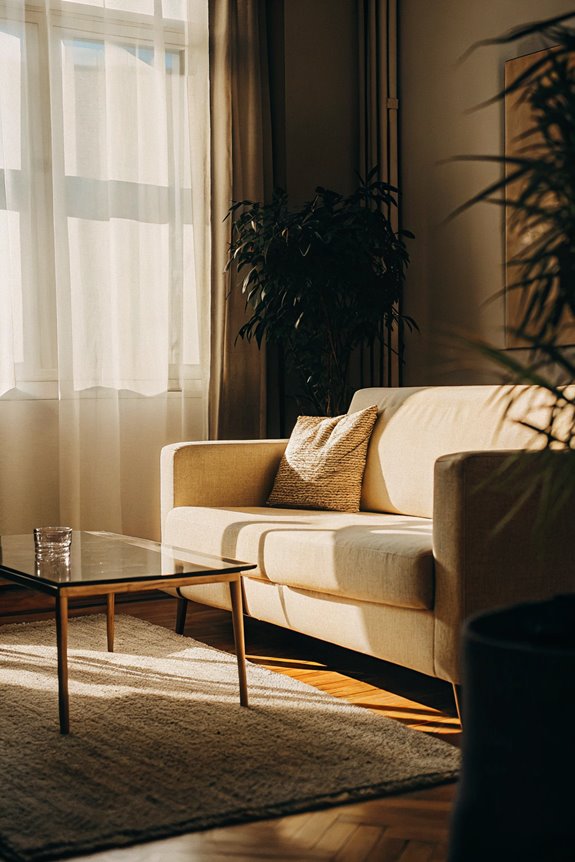
Opting for simple window treatments can considerably enhance the minimalist aesthetic of a living room. Sheer curtains offer a delicate touch, allowing natural light to filter through while maintaining privacy. Their lightweight fabric creates an airy feel, which aligns perfectly with minimalist principles.
In contrast, bamboo blinds introduce an organic texture, complementing the clean lines and neutral palettes typical of minimalist design. "Both options provide functionality without overwhelming the space," notes interior designer Jane Doe.
Minimalist Accessories
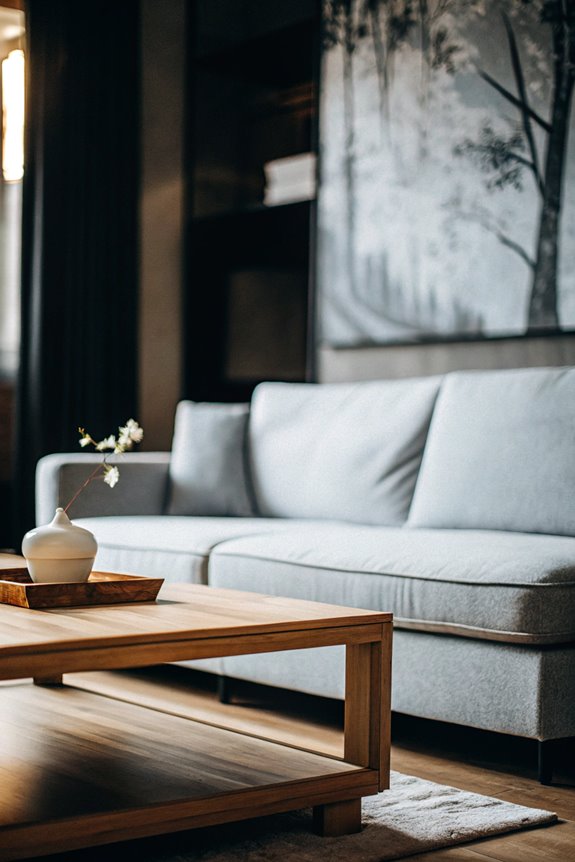
The essence of minimalist living room design is often captured through carefully curated accessories that enhance the overall aesthetic without cluttering the space.
Effective accessory selection is vital in achieving a harmonious balance within minimalist decor, where each piece serves a purpose and contributes to the ambiance.
Consider incorporating the following elements for a sophisticated touch:
- Sculptural Vases: Simple shapes in neutral tones can add elegance.
- Geometric Wall Art: Abstract designs create visual interest without overwhelming.
- Textured Throws: A single, high-quality throw can introduce warmth and comfort.
- Statement Lighting: A sleek, modern lamp can act as a focal point.
These accessories not only reflect personal style but also reinforce the clean lines and open feel characteristic of minimalist living spaces.
Zen-inspired Retreat
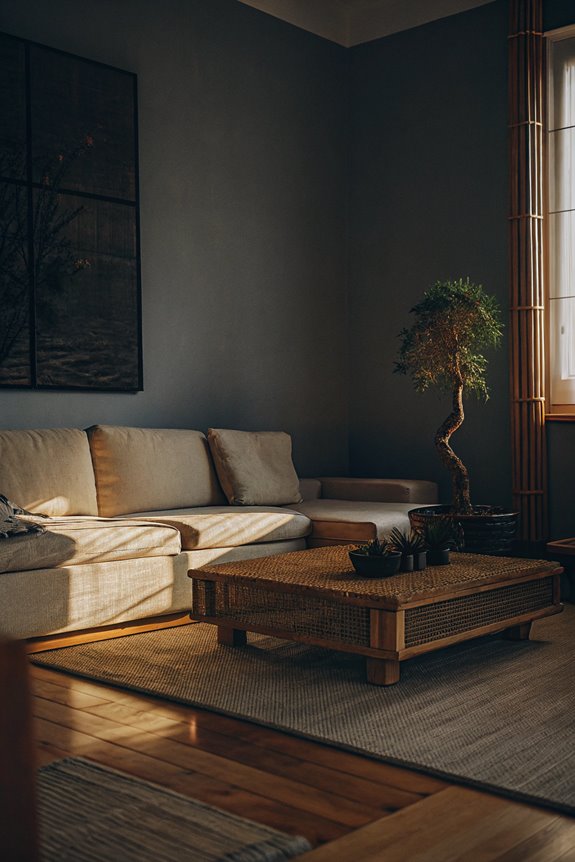
While cultivating a Zen-inspired retreat within your living room, the focus shifts to creating a serene environment that promotes relaxation and mindfulness.
Emphasizing zen aesthetics, opt for furniture with clean lines and natural materials, such as bamboo or light woods, which foster a connection with nature. Serene colors, like soft greens, warm neutrals, and calming blues, can enhance tranquility while allowing for a cohesive design.
Incorporate minimal decor, such as a single bonsai tree or a carefully placed stone sculpture, to serve as focal points without overwhelming the space.
According to interior designer Jane Doe, "A Zen-inspired living room should evoke peace, allowing individuals to unwind easily."
This approach not only elevates aesthetics but also nurtures overall well-being.
Small Space Solutions
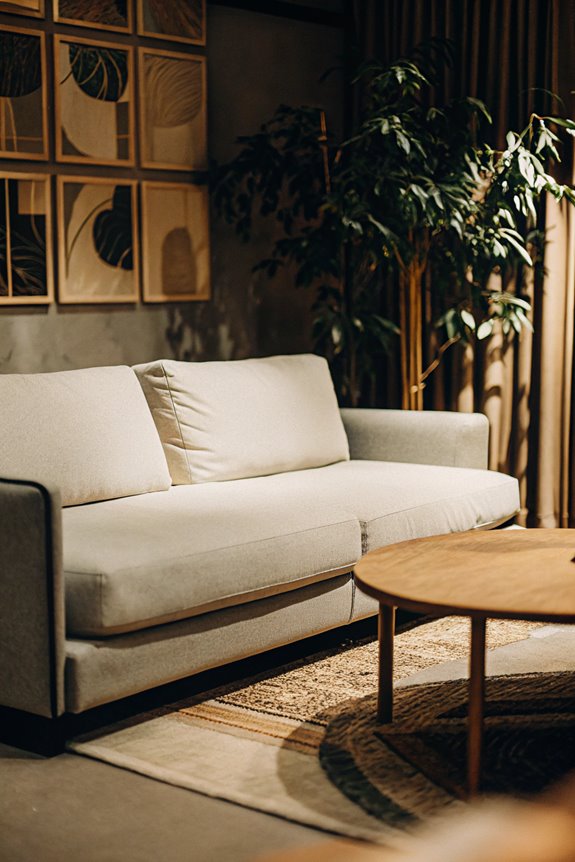
Creating a functional and stylish living room in a small space requires innovative solutions that maximize both aesthetics and utility. Incorporating space-saving furniture and multifunctional decor can transform limited areas into inviting retreats.
Expert designers emphasize the importance of selecting pieces that serve dual purposes, allowing homeowners to enjoy both efficiency and style.
- Modular seating that adapts to various configurations
- Nesting tables for flexible surface area
- Wall-mounted shelves that free up floor space
- Ottomans with hidden storage for added functionality
These strategies not only enhance the visual appeal of small living rooms but also promote an organized environment.
Timeless Minimalism
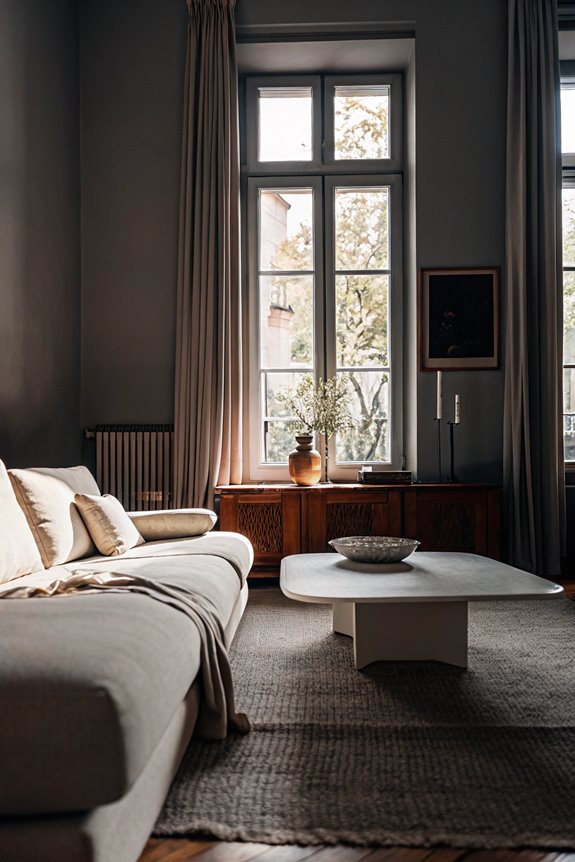
Embracing timeless minimalism involves curating a space that prioritizes simplicity and functionality without sacrificing style. This design philosophy emphasizes clean lines and a neutral palette, fostering an atmosphere that feels both calming and sophisticated.
Timeless design transcends fleeting trends, focusing on high-quality materials and enduring style that remains relevant through the years. Renowned designer John Pawson asserts, "Minimalism is not a lack of something; it's a perfect amount of something."

